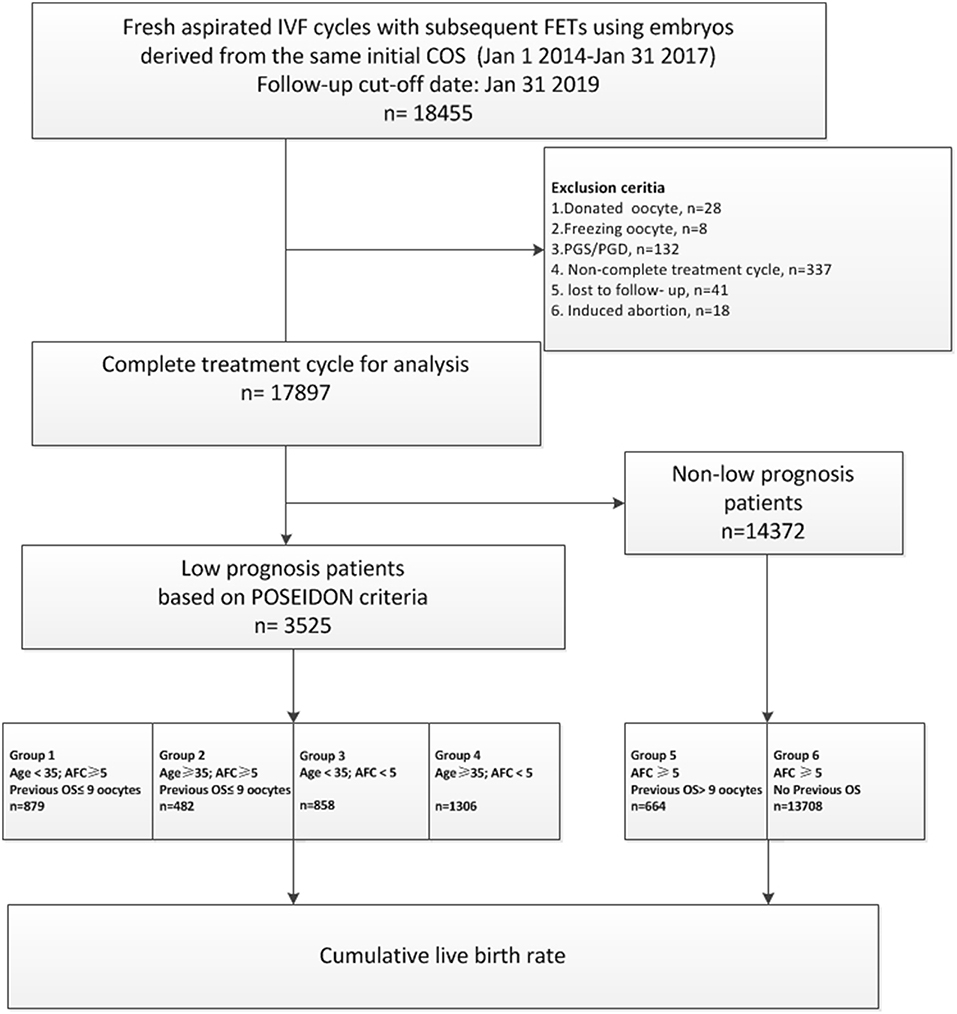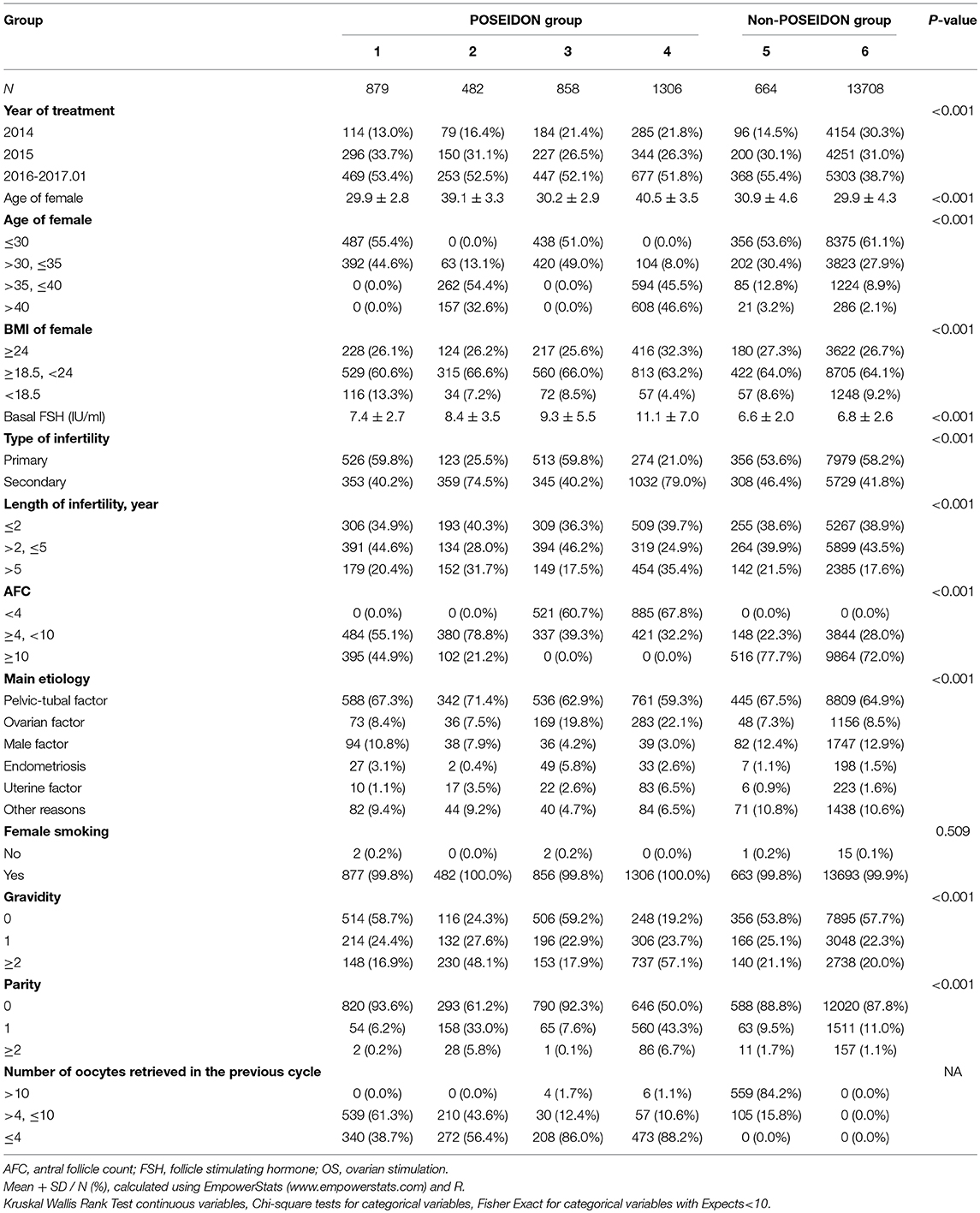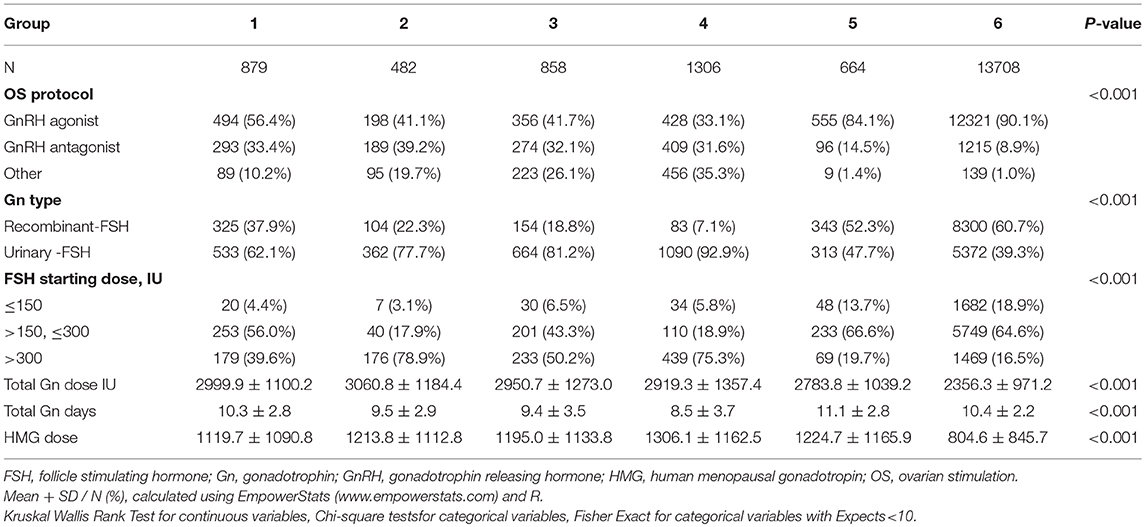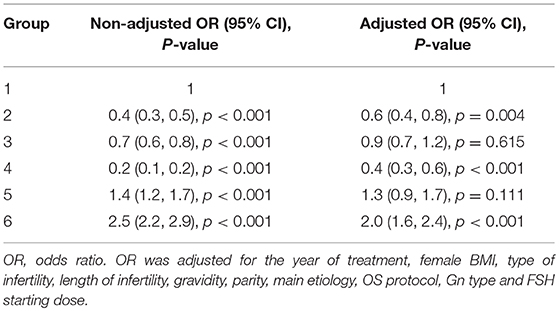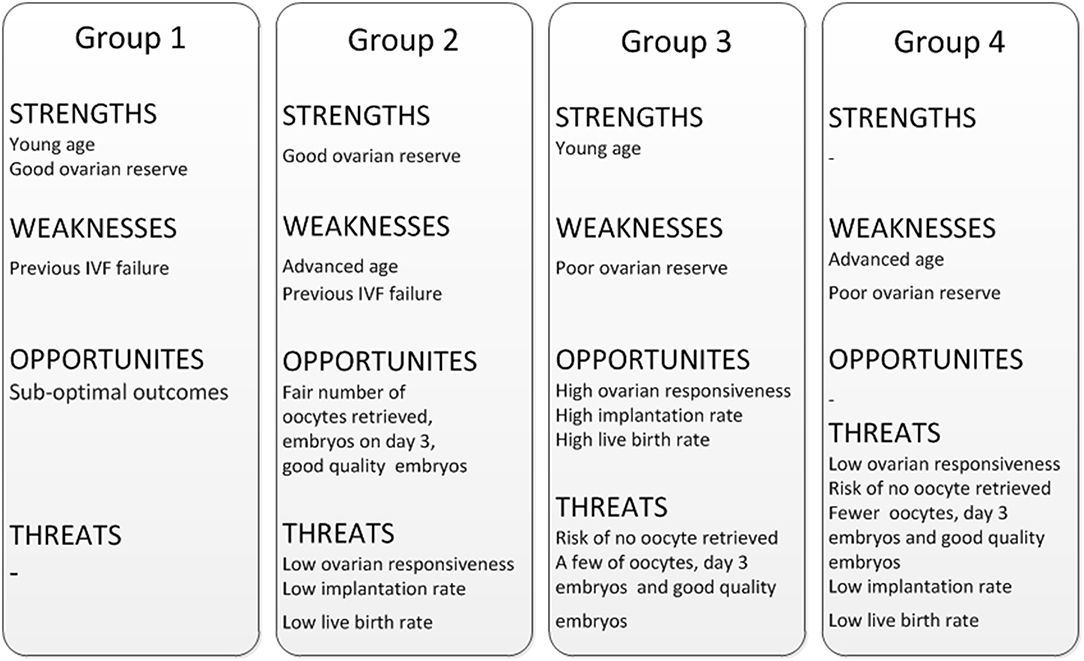- 1The Assisted Reproduction Center, Northwest Women's and Children's Hospital, Xi'an, China
- 2Department of Respiratory Medicine, Shaanxi Provincial People's Hospital, Xi'an, China
Objective: To investigate the characteristics and outcomes of low prognosis patients defined by POSEIDON criteria undergoing IVF treatment.
Design: Retrospective cohort analysis.
Setting: An IVF clinic in a public hospital.
Patients: 18,455 fresh aspirated IVF cycles with subsequently frozen embryo transfer from Jan 2014 to Jan 2017 in a single IVF clinic were included in the analysis. The low prognosis patients were categorized into 4 groups based on POSEIDON criteria: group 1: age < 35, antral follicle count (AFC) ≥ 5, number of oocytes retrieved ≤ 9 in the previous cycle; group 2: age ≥ 35, AFC≥5, number of oocytes retrieved ≤ 9 in the previous cycle; group 3: age < 35, AFC < 5; group 4: age ≥ 35, AFC < 5. The non-low prognosis patients: group 5: AFC ≥ 5, previous number of oocytes retrieved > 9 oocytes; group 6: AFC ≥ 5, no previous ovarian stimulation.
Intervention(s): None.
Main Outcome Measure: The primary outcome was cumulative live birth rate (CLBR).
Result(s): Taking group 1 as reference, the CLBR from young women in group 3 (35.5%, OR 0.9, 95% CI 0.7–1.2) was slightly lower than that in group 1 (44.6%, p = 0.615). The CLBR in group 2 (24.5%, OR 0.6, 95% CI 0.4–0.8, p = 0.004) and group 4 (12.7%, OR 0.4, 95% CI 0.3–0.6, p < 0.001) was significant lower than that in group 1. In non-poor prognosis patients, the CLBR from young women in group 5 (53.5% OR 1.3 95% CI 0.9, 1.7, p = 0.111) was a slight higher than the reference group 1 while the highest CLBR was originated from the first IVF patients with good ovarian reserve in group 6 (66.9%, OR 2.0, 95% CI 1.6, 2.4).
Conclusion(s): The CLBRs and implantation rates in the young women (group 3) with diminished ovarian reserve was similar in those young women (group 1), and was significantly higher than in advanced age women with a fair ovarian reserve (group 2). Though patients in group 2 had better ovarian reserve, more oocytes and more embryos, the pregnancy outcome was inferior to that of group 3 patients with poorer ovarian reserve, fewer oocytes and fewer embryos.
Introduction
Recently a novel system, the POSEIDON criteria, was developed to classify infertility patients with low prognosis undergoing assisted reproductive technology (ART) treatment (1). It is a useful system for the identification and classification of patients with impaired ovarian reserve or poor ovarian response (POR), providing guidance for the diagnosis and management of these patients (2). Four subsets have been suggested based on quantitative and qualitative parameters including, age, ovarian reserve biomarkers, and ovarian response. The new criteria, by introducing a more detailed stratification of POR, significantly reduced the heterogeneity of patients meeting the Bologna criteria (3), which may differentiate patient subsets within the POR population who could be identified and benefit from specific interventions (4). Although the POSEIDON criteria were established, along with some specific treatment recommendations proposed for the specific patient subgroups (5), there still remains insufficient evidence to support the validity of parameters used in the POSEIDON criteria, as well as the outcome assessment of different subgroups.
Among the four groups based on the POSEIDON criteria, group 1 is undoubtedly the best prognostic group considering their younger age and normal ovarian reserve, while group 4 has the worst prognosis due to the advanced age and diminished ovarian reserve. However, an interesting question is who would achieve better pregnancy outcome, the older women (group 2) with normal ovarian reserve or the young women (group 3) with diminished ovarian reserve. The cumulative live birth rate (CLBR) is considered a preferable measure of success of IVF treatment (6). Until now, there have been very few reports on the CLBRs of the four patient groups defined by the POSEIDON criteria.
The characteristics and prognosis of patients should be used to develop clinical management strategies. The objective of this study is to characterize the low prognosis patients in order to facilitate treatment decision making. In this study, the baseline characteristics and outcomes of patient groups defined by the POSEIDON criteria were analyzed, and CLBR resulting from one aspirated in-vitro fertilization (IVF)/intracytoplasmic sperm injection (ICSI) cycle was proposed as the primary outcome measurement for low prognosis patients undergoing IVF treatment (7).
Materials and Methods
This retrospective study included 18,455 fresh aspirated IVF cycles with subsequent frozen embryo transfers from January 2014 to January 2017 in our center. The live birth outcome was followed up for at least 2 years until Jan 2019. The study was approved by the Ethics Committee for the Clinical Application of Human Assisted Reproductive Technology of Northwest Women's and Children's Hospital (No. 2018002). The ethics committee approved this study waived the need to obtain informed consent. All research was performed in accordance with relevant guidelines and regulations.
Inclusion Criteria
All fresh IVF/ICSI cycles and subsequently frozen embryo transfers from oocyte retrievals performed in our clinic from January 2014 to January 2017 were included in the analysis. The following cycles were excluded: (1) donated oocyte cycles (n = 28), oocyte freezing cycles (n = 8); (2) PGS/PGD cycles (n = 132); (3) cycles without live birth but with extra frozen embryos during this period (n = 337); (4) cycles of patients lost to follow-up (n = 41); (5) cycles with induced abortion (n = 18).
Patients were categorized according to POSEIDON criteria:
Low prognosis patients
Group 1 (n = 879 cycles): Age < 35, antral follicle count (AFC) ≥ 5, number of oocytes retrieved ≤ 9 in the previous cycle;
Group 2 (n = 482 cycles): Age ≥ 35, AFC≥5, previous number of oocytes retrieved ≤ 9 in the previous cycle;
Group 3 (n = 858 cycles): Age < 35, AFC < 5;
Group 4 (n = 1,306 cycles): Age ≥ 35, AFC < 5;
Non-low prognosis patients
Group 5 (n = 664 cycles): AFC ≥ 5, previous ovarian stimulation > 9 oocytes;
Group 6 (n = 13708 cycles): AFC ≥ 5, no previous ovarian stimulation.
Flow chart and data processing procedure are listed in Figure 1. Demographics and basal characteristics of patients are presented in Table 1.
Ovarian Stimulation and Oocyte Retrieval
The protocol for ovarian stimulation (OS) was determined individually according to female age, body mass index (BMI), basal follicle stimulating hormone (FSH) and antral follicle count (AFC). 94.33% of IVF patients received recombinant and/or urinary gonadotrophins (rFSH/hMG) in GnRH agonist protocol or GnRH antagonist protocol followed by IVF or ICSI. For women with diminished ovarian reserve, the mild stimulation protocol or luteal phase ovarian stimulation or natural cycle was used. Human menopausal gonadotrophin (hMG, Li Zhu, China) was added in mild ovulation protocol or Shanghai protocol according to patients' response to stimulation. Human chorionic gonadotrophin (hCG) 4,000–10,000 IU or recombinant hCG (r-hCG, MerckSerono S.p.A.) 250μg was administered when 2-3 follicles reached the size of 17 mm or higher. Thirty-six hours later, oocyte retrieval was performed using transvaginal ultrasonography-guided aspiration. The ovarian stimulation parameters of each group are listed in Table 2.
Embryo Transfer Policy
The oocyte processing and embryo development procedures as well as the embryo scoring system were described in our previous articles (8, 9). Grade 1–3 embryos on day 3 were considered useable embryos, and Grade 1–2 embryos were considered good-quality embryos. All fresh embryo transfers (ETs) were carried out on day 3 or day 5. In cases with sufficient number (≥ 3–4) of good-quality embryos on day 3, blastocyst transfer on day 5 would be practiced. Apart from the transferred embryos, patients' extra embryos were vitrified on day 3 or on blastocyst stage (day 5–6). Grade 1–3 cleavage stage embryos on day 3 and blastocysts with Gardner score above 4CC were cryopreserved (Cryo-top, open system, Kuwayama). The methods and Frozen ET procedure are detailed in previous verification study by our team (8, 9). If the implantation failed in fresh cycle, the frozen-thawed embryo transfer (FET) would be carried out using the remaining vitrified embryos or blastocysts. Patients under the age of 35 with good quality embryos were encouraged to receive a single-embryo transfer. A single embryo transfer policy was also applied for the patients who have the be abnormal uterus (e.g., scarred uterus, uterine malformation) and/ or other cases conflicted with twin pregnancy. Progesterone intramuscular injection (60 mg/day) was given for luteal phase support from the oocyte retrieval day until a negative serum beta-hCG or 8 weeks of pregnancy.
Primary Outcome Measurements and Statistical Analysis
The primary outcome was cumulative live birth (CLB) defined as at least one live birth resulting from one aspirated ART cycle in the fresh ET or in the subsequent FET in relation to the number of oocytes retrieved. The numerator of CLBR calculation was the sum of live births achieved in the FETs and live births in fresh cycles. Only the first delivery was counted in the analysis if a patient achieved multiple deliveries. The CLBR was defined the cumulative live birth per transvaginal oocyte aspiration accordant to terminology definition (7, 10) One treatment cycle was defined as an oocyte retrieval. One complete treatment cycle referred to a treatment cycle that reached live birth or a treatment cycle that failed to reach live birth with all the embryos transferred. The cumulative live birth rate in this study was calculated based on the complete treatment cycle, so the patients (n = 337) of non-complete treatment were excluded.
The data processing and statistical analysis were performed using EmpowerStats software (www.empowerstats.com) and statistical software packages R. To assess the odds ratio (OR) of CLBR in different patient groups, a multiple variables regression model was established with potential confounding factors as the variables and adjusted for the year of treatment, female BMI, type of infertility, length of infertility, gravidity, parity, main etiology, OS protocol, gonadotrophin type, and FSH starting dose. Patients were enrolled for 3 years, during which IVF procedure was revised. To eliminate bias caused by this factor, the cumulative live birth rate was adjusted for the year of treatment. Female BMI, type of infertility, length of infertility, gravidity, parity, and main etiology were important factors affecting pregnancy and live birth through experience or literature. OS protocol, gonadotrophin type and FSH starting dose are the key indicators to affect the number of oocytes retrieved and ultimately the cumulative chance of live births.
Results
Oocyte and Embryo Parameters
As shown in Table 3, the number of oocytes retrieved decreased in low prognosis patients from group 1 to group 4 (p < 0.001), as well as number of 2 pro-nucleus (2PN) zygotes (p < 0.001), number of day 3 usable embryos (p < 0.001) and number of good quality embryos (p < 0.001). Oocyte output rate (number of oocyte retrieved/AFC x 100%) was highest in group 3 (145.3%), followed by group 4 (101.2%), group 1 (74.0%), and group 2 (67.3%).
Pregnancy Outcomes and Cumulative Live Birth Rate (CLBR)
Inconsistent with the distribution pattern of number of oocytes and embryos by group, the CLBRs in the order from highest to lowest was 44.6% in group 1(n = 879), 35.5% in group 3(n = 858), 24.5% in group 2 (n = 482) and 12.7% in group 4 (n = 1306). A multiple-variable regression analysis was performed with variables that may act as confounding factors described in Tables 1, 2. The adjusted odds ratios (ORs) of CLBR with their 95% confidence intervals (CIs) were shown in Table 4. Consistent with the trend of non-adjusted results, the CLBR in group 3 (OR 0.9, 95% CI 0.7–1.2, p = 0.615) was slightly lower and group 5 (OR 1.3, 95% CI 0.9–1.7, p = 0.111) was slightly higher than CLBR in group 1 without significant statistical difference. The CLBR in group 2 was significantly lower than in group 1 (OR 0.6, 95% CI 0.4–0.8, p = 0.004) and CLBR in group 4 was the lowest (OR 0.4, 95% CI 0.3–0.6, p < 0.001) as compared to group 1. Table 5 showed the pregnancy outcomes per fresh transfer or FET in low prognosis patients. The implantation rates in aged groups (group 2 and group 4) were significantly lower than in young groups (group 1 and group 3).

Table 5. Pregnancy outcomes per transfer both fresh and frozen embryo transfer in low prognosis patients.
Figure 2 showed the trend chart of key events in low prognosis patients. There was a crossing of trend lines between group 2 and group 3 after embryo transfer. Patients in group 2 (age ≥35; AFC ≥ 5) had higher AFC, more oocytes retrieved, more embryos and more good quality embryos, but decreased implantation rate and CLBR. On the contrary, though patients in group 3 (age < 35; AFC < 5) had fewer oocytes and embryos, the CLBR turned out higher than that in group 2. The SWOT analysis of 4 groups of low prognosis patients defined by POSEIDON criteria is shown in Figure 3.
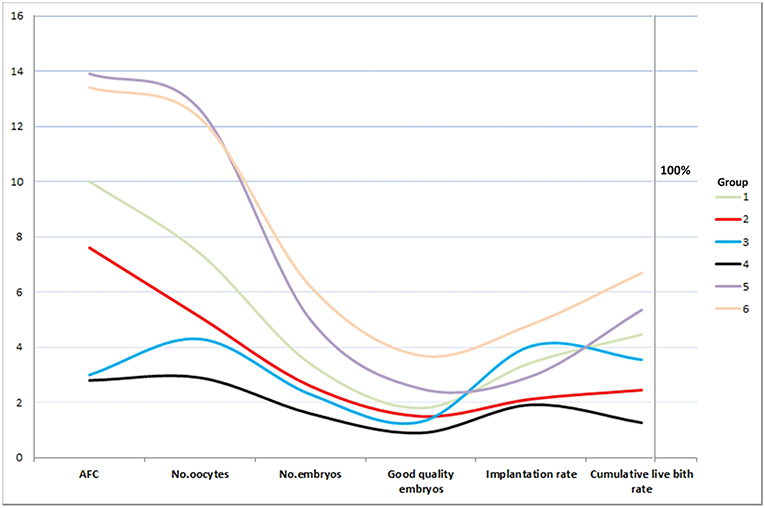
Figure 2. Trend chart of key events in low prognosis patients. There was a crossing of trend lines between group 2 (red) and group 3 (blue) after embryo transfer. X axis represents the average number of AFC, number of oocytes, number embryos, number of good quality embryos, rate of implantation and rate of cumulative live birth. The Y axis on the left represents the number of the first four variables (n) and the Y axis on the right represents the rate of last two variables (%).
Discussion
The main finding of this retrospective study in POSEIDON criteria-defined population was that the CLBR was highest in group 1, followed by group 3 and group 2, and lowest in group 4. According to our results, the CLBR from the young women with poor ovarian reserve (group 3) was slightly lower than that from young women with good ovarian reserve and previous low responder (group 1). Though the patients in group 2 (age ≥ 35; AFC ≥ 5) had better ovarian reserve, more oocytes and more embryos, the CLBR and implantation rate, on the other way round, were lower than in group 3 patients with poorer ovarian reserve, fewer oocytes and fewer embryos. This finding may facilitate the development of management strategies for low prognosis patients.
The innovative POSEIDON criteria aim at identifying and stratifying low prognosis patients into four distinct groups based on female age, AFC and ovarian response in the previous cycle (4). The patients in group 2 were characterized by good ovarian reserve and advanced age, exactly the opposite of group 3 patients with poor ovarian reserve but are at younger age. Studies (11–13) have shown that CLBR increases with the number of oocytes retrieved even in the women of advanced age (14). It was suggested the number of oocytes retrieved is a very important variable independently associated with CLBR. Patients in group 2 with a higher number of oocytes were expected to have a better prognosis than patients in group 3, because group 2 patients had more embryos to transfer. However, the CLBR and implantation rate were reversely higher in group 2 than in group 3.
Our results are consistent with previous studies (15, 16) on the association of ovarian reserve and pregnancy outcome. Chang et al. (15) found that there were lower rates of normal fertilization, cleavage, high-quality embryos, implantation, and pregnancy in older women than in younger women with diminished ovarian reserve. The primary reason was the adverse impact of aging oocyte on the pregnancy outcome (low implantation rate and high pregnancy loss rate) due to chromosomal abnormalities (17) and cytoplasmic dysfunction (18). The decline in fertility with aging involves both quantity and quality of oocyte. Implantation and miscarriage are related to the quality of oocytes but not necessarily the ovarian reserve (16). The fair ovarian reserve in group 2 would increase the possibility of obtaining more oocytes and embryos to transfer, but at the same time, the higher aneuploidy rate would lead to low implantation rate and high miscarriage rate.
In terms of the management of patients in group 2, more attention should be paid to develop strategies of improving the oocyte quality rather than oocyte quantity or embryo quantity. Because more embryos are achieved on day 3 in group 2, culturing embryos to blastocyst stage for transfer is a good option. Day 5–6 embryos have lower rate of segmental aneuploidy (19) and higher viability for implantation (20) than day 2–3 embryos. Preimplantation genetic testing for aneuploidies (PGT-A) are also beneficial for advanced women to select an euploid embryo to transfer (21). An optimal ovarian stimulation regimen to improve the quality of oocytes (22, 23) could be an alternative option. Supplements such as dehydroepiandrosterone were tried to improve follicle development (24), though there is insufficient evidence to support their use in these patients.
The patients in group 3 (age < 35; AFC < 5) had a poor ovarian reserve, who were expected poor responders with poor pregnancy outcome. Interestingly, the oocytes output rate (145.3% oocytes retrieved per AFC) in group 3 was significantly higher than in the other groups, though FSH starting dose was not significantly increased (Table 2). This suggested the response of antral follicles to gonadotropin may have reached the limit of its ability, therefore there will be no additional benefit in oocyte number to further increase daily gonadotrophin doses (25). Evaluating ovarian sensitivity to FSH is a key element to improve IVF success rates in these low prognosis patients and open new treatment perspectives (26). The high oocytes output rate per AFC in group 3 also supported the reported recommendation of maximum daily dose of 300 IU rFSH (5). For the patients in group 3, more efforts should be focused on increasing the number of oocytes, as the clinical pregnancy outcome is reassured once oocytes are acquired.
The patients in group 5 were the non-low prognosis patients who had good ovarian response (more than 9 oocytes in previous retrieval), however most of these patients failed to live birth in previous IVF cycle. Comparing with another non-low prognosis patients with first IVF treatment (group 6), though the patients in group 5 have more AFC and number of oocytes retrieved, the embryo development and pregnancy outcome were inferior to that in group 6. Therefore, the failure in first IVF patients with good ovarian response may be the poor prognosis for subsequently IVF treatment.
Pelvic-tubal factor is the most common cause of infertility, accounting for about 10.8–78.3% of infertile women in China (27, 28). Tubal factor mainly involves tubal occlusion and peritoneal pathology causing adhesions, which was diagnosed by hysterosalpingography and laparoscopy. The prevalent cause of tubal factor infertility was attributed to pelvic inflammatory disease (PID), salpingitis and endometriosis (29). In the patient groups of this study, tubal factor is the main infertility etiology, ranging from 62.9 to 71.4%, which was higher than that in infertility women of other countries and regions. Therefore, it should be careful to interpret the wider implications of the findings.
Limitations are related to the retrospective nature of the study and the fact that the data was from a single center also weakens the universality of our observations. Other potential limitations could be that non-GnRH analog protocol was used in some women with diminished ovarian reserve rather than in those with normal ovarian reserve. The fresh cycles that failed to yield any oocyte were not included in this study, for example, cycles with cancellation of ovarian stimulation.
The results of this study may provide new insights for the development of management strategies for low prognosis patients. A SWOT analysis was performed to help the management for poor prognosis patients in clinic, which was drawn from the POSEIDON reports (1, 2, 4, 5) and the data in this study. The responsiveness of antral follicles to gonadotrophin was extremely higher in group 3 than in the other groups. Considering the gratifying CLBR outcome in group 3, in order to increase oocyte yield, we suggest to try more ovarian stimulations but not harder ovarian stimulation through excessive daily gonadotrophin dose. Though the patients in group 2 have more ovarian reserve as well as more oocytes and embryos, the CLBR was lower than expected. The management strategy for group 2 should be improving the live birth rate rather than increasing number of oocytes retrieved.
Conclusion
In conclusion, inconsistent with the distribution pattern of oocyte quantity and embryo quantity by patient group, the CLBRs in the order from highest to lowest were in group 1 (young women with good ovarian reserve), group 3 (young women with poor ovarian reserve), group 2 (women at advanced age with good ovarian reserve), and at last group 4 (women at advanced age with poor ovarian reserve.
Data Availability
The raw data supporting the conclusions of this manuscript will be made available by the authors, without undue reservation, to any qualified researcher.
Ethics Statement
The study was approved by the Ethics Committee for the Clinical Application of Human Assisted Reproductive Technology of Northwest Women's and Children's Hospital (No. 2018002). The ethics committee that approved this study waived the need to obtain informed consent. All of the research was performed in accordance with the relevant guidelines and regulations.
Author Contributions
WS and JS conceived and designed the study. WS and WZ drafted and revised the manuscript. WS, ZZ, and WZ analyzed and interpreted the data. LT, ZZ, and HZ collected and cleared the data. All authors have read and approved the final version of the manuscript.
Funding
The study was funded by General Projects of Social Development in Shaanxi Province (No. 2018SF-247) and Personnel Training Program of Northwest women and children's Hospital (2018ZD02).
Conflict of Interest Statement
The authors declare that the research was conducted in the absence of any commercial or financial relationships that could be construed as a potential conflict of interest.
Acknowledgments
We thank all the clinicians, scientists and embryologists in the Northwest Women and Children's Hospital for their assistance with the data collection, and all the patients for their contribution to this study. We gratefully thank Dr. Xinglin Chen from Department of Epidemiology and Biostatistics, X&Y solutions Inc. in Boston for her contribution to the statistical support.
References
1. Alviggi C, Andersen CY, Buehler K, Conforti A, De Placido G, Esteves SC, et al. A new more detailed stratification of low responders to ovarian stimulation: from a poor ovarian response to a low prognosis concept. Fertil Steril. (2016) 105:1452–3. doi: 10.1016/j.fertnstert.2016.02.005
2. Humaidan P, Alviggi C, Fischer R, Esteves SC. The novel POSEIDON stratification of “Low prognosis patients in assisted reproductive technology' and its proposed marker of successful outcome. F1000Res. (2016) 5:2911. doi: 10.12688/f1000research.10382.1
3. Ferraretti AP, La Marca A, Fauser BC, Tarlatzis B, Nargund G, Gianaroli L, et al. ESHRE consensus on the definition of 'poor response' to ovarian stimulation for in vitro fertilization: the Bologna criteria. Hum Reprod. (2011) 26:1616–24. doi: 10.1093/humrep/der092
4. Esteves SC, Roque M, Bedoschi GM, Conforti A, Humaidan P, Alviggi C. Defining low prognosis patients undergoing assisted reproductive technology: POSEIDON criteria-the why. Front Endocrinol. (2018) 9:461. doi: 10.3389/fendo.2018.00461
5. Haahr T, Esteves SC, Humaidan P. Individualized controlled ovarian stimulation in expected poor-responders: an update. Reprod Biol Endocrinol. (2018) 16:20. doi: 10.1186/s12958-018-0342-1
6. Maheshwari A, McLernon D, Bhattacharya S. Cumulative live birth rate: time for a consensus? Human Reprod. (2015) 30:2703–7. doi: 10.1093/humrep/dev263
7. Zegers-Hochschild F, Adamson GD, Dyer S, Racowsky C, de Mouzon J, Sokol R, et al. The International glossary on infertility and fertility care 2017. Fertil Steril. (2017) 108:393–406. doi: 10.1016/j.fertnstert.2017.06.005
8. Shi W, Zhang S, Zhao W, Xia X, Wang M, Wang H, et al. Factors related to clinical pregnancy after vitrified-warmed embryo transfer: a retrospective and multivariate logistic regression analysis of 2313 transfer cycles. Hum Reprod. (2013) 28:1768–75. doi: 10.1093/humrep/det094
9. Shi W, Xue X, Zhang S, Zhao W, Liu S, Zhou H, et al. Perinatal and neonatal outcomes of 494 babies delivered from 972 vitrified embryo transfers. Fertil Steril. (2012) 97:1338–42. doi: 10.1016/j.fertnstert.2012.02.051
10. Yovich JL, James D. Cumulative live birth rate: an outmoded term. J Fertil: In Vitro IVF-Worldwide Reprod Med Genet Stem Cell Biol. (2016) 4:1000165. doi: 10.4172/2375-4508.1000165
11. Polyzos NP, Drakopoulos P, Parra J, Pellicer A, Santos-Ribeiro S, Tournaye H, et al. Cumulative live birth rates according to the number of oocytes retrieved after the first ovarian stimulation for in vitro fertilization/intracytoplasmic sperm injection: a multicenter multinational analysis including approximately 15,000 women. Fertil Steril. (2018) 110:661–70 e1. doi: 10.1016/j.fertnstert.2018.04.039
12. Zhou J, Wang B, Hu Y, Sun H. Association between the number of oocytes retrieved and cumulative live birth rate in women aged 35-40 years undergoing long GnRH agonist IVF/ICSI cycles. Arch Gynecol Obstet. (2017) 296:1005–12. doi: 10.1007/s00404-017-4503-9
13. Malchau SS, Henningsen AA, Forman J, Loft A, Nyboe Andersen A, Pinborg A. Cumulative live birth rate prognosis based on the number of aspirated oocytes in previous ART cycles. Hum Reprod. (2019) 34:171–80. doi: 10.1093/humrep/dey341
14. Devesa M, Tur R, Rodriguez I, Coroleu B, Martinez F, Polyzos NP. Cumulative live birth rates and number of oocytes retrieved in women of advanced age. A single centre analysis including 4500 women >/ = 38 years old. Hum Reprod. (2018) 33:2010–17. doi: 10.1093/humrep/dey295
15. Chang Y, Li J, Li X, Liu H, Liang X. Egg quality and pregnancy outcome in young infertile women with diminished ovarian reserve. Med Sci Monit. (2018) 24:7279–84. doi: 10.12659/MSM.910410
16. Bishop LA, Richter KS, Patounakis G, Andriani L, Moon K, Devine K. Diminished ovarian reserve as measured by means of baseline follicle-stimulating hormone and antral follicle count is not associated with pregnancy loss in younger in vitro fertilization patients. Fertil Steril. (2017) 108:980–7. doi: 10.1016/j.fertnstert.2017.09.011
17. Igarashi H, Takahashi T, Nagase S. Oocyte aging underlies female reproductive aging: biological mechanisms and therapeutic strategies. Reprod Med Biol. (2015) 14:159–69. doi: 10.1007/s12522-015-0209-5
18. Benkhalifa M, Ferreira YJ, Chahine H, Louanjli N, Miron P, Merviel P, et al. Mitochondria: participation to infertility as source of energy and cause of senescence. Int J Biochem Cell Biol. (2014) 55:60–4. doi: 10.1016/j.biocel.2014.08.011
19. Babariya D, Fragouli E, Alfarawati S, Spath K, Wells D. The incidence and origin of segmental aneuploidy in human oocytes and preimplantation embryos. Hum Reprod. (2017) 32:2549–60. doi: 10.1093/humrep/dex324
20. Zeng M, Su S, Li L. Comparison of pregnancy outcomes after vitrification at the cleavage and blastocyst stage: a meta-analysis. J Assist Reprod Genet. (2018) 35:127–34. doi: 10.1007/s10815-017-1040-1
21. Munne S. Status of preimplantation genetic testing and embryo selection. Reprod Biomed Online. (2018) 37:393–6. doi: 10.1016/j.rbmo.2018.08.001
22. Lin LT, Vitale SG, Chen SN, Wen ZH, Tsai HW, Chern CU, et al. Luteal phase ovarian stimulation may improve oocyte retrieval and oocyte quality in poor ovarian responders undergoing in vitro fertilization: preliminary results from a single-center prospective pilot study. Adv Ther. (2018) 35:847–56. doi: 10.1007/s12325-018-0713-1
23. Duport Percier M, Anahory T, Ranisavljevic N, Bringer-Deutsch S. [Poor responders: How could we improve our results?]. Gynecol Obstet Fertil Senol. (2017) 45:95–103. doi: 10.1016/j.gofs.2016.12.023
24. Narkwichean A, Maalouf W, Baumgarten M, Polanski L, Raine-Fenning N, Campbell B, et al. Efficacy of dehydroepiandrosterone (DHEA) to overcome the effect of ovarian ageing (DITTO): a proof of principle double blinded randomized placebo controlled trial. Eur J Obstet Gynecol Reprod Biol. (2017) 218:39–48. doi: 10.1016/j.ejogrb.2017.09.006
25. Cohen J, Mounsambote L, Prier P, Mathieu d AE, Selleret L, Chabbert-Buffet N, et al. Outcomes of first IVF/ICSI in young women with diminished ovarian reserve. Minerva Ginecol. (2017) 69:315–21. doi: 10.23736/s0026-4784.16.04003-x
26. Grynberg M, Labrosse J. Understanding follicular output rate (FORT) and its implications for POSEIDON criteria. Front Endocrinol. (2019) 10:246. doi: 10.3389/fendo.2019.00246
27. Hou LY. Epidemiological Study on Infertility in Three Provinces of China. Phd Thesis, Graduate School of Peking Union Medical College, Beijing, China (2011).
28. Zhu Hui-li HW. Epidemiology and etiology of oviduct infertility. J Int Reprod Health/Family Plann. (2016) 35:212–216.
Keywords: POSEIDON, cumulative live birth, implantation rate, miscarriage rate, low prognosis patient
Citation: Shi W, Zhou H, Tian L, Zhao Z, Zhang W and Shi J (2019) Cumulative Live Birth Rates of Good and Low Prognosis Patients According to POSEIDON Criteria: A Single Center Analysis of 18,455 Treatment Cycles. Front. Endocrinol. 10:409. doi: 10.3389/fendo.2019.00409
Received: 30 April 2019; Accepted: 07 June 2019;
Published: 26 June 2019.
Edited by:
John Lui Yovich, Pivet Medical Center, AustraliaCopyright © 2019 Shi, Zhou, Tian, Zhao, Zhang and Shi. This is an open-access article distributed under the terms of the Creative Commons Attribution License (CC BY). The use, distribution or reproduction in other forums is permitted, provided the original author(s) and the copyright owner(s) are credited and that the original publication in this journal is cited, in accordance with accepted academic practice. No use, distribution or reproduction is permitted which does not comply with these terms.
*Correspondence: Wei Zhang, emhhbmd3ZWlfODIzQHllYWgubmV0; Juanzi Shi, c2hpanVhbnppMTIzQDEyNi5jb20=
 Wenhao Shi1
Wenhao Shi1 Li Tian
Li Tian Juanzi Shi
Juanzi Shi